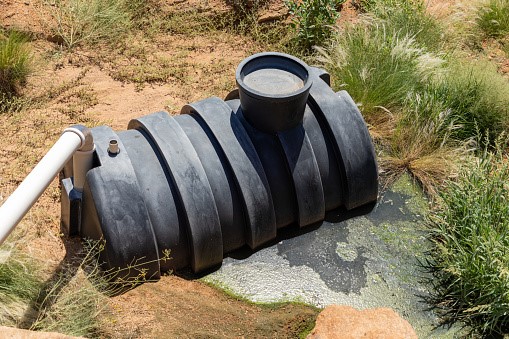As with any home system, issues with septic tanks can arise. Identifying and solving these problems promptly can save you time, money, and headaches. In this guide, you’ll learn more about septic tanks, the signs and causes of common septic tank problems, how to avoid them, and solutions for when issues occur.
How Septic Tanks Work
Septic tanks are underground storage systems that treat and dispose of wastewater for homes without traditional sewer connections. As a result, septic tanks are most commonly found in rural communities.
The tank separates solids from liquids, allowing the solids to settle at the bottom and the effluent to flow out into the drain field. Bacteria break down the solid waste into sludge, while the liquid waste filters through the soil in the drain field. This removes any remaining pathogens before percolating into the groundwater supply.
Signs of Septic Tank Problems
Detecting problems early is essential to prevent more significant issues from developing that could lead to expensive repairs or a complete system replacement. Watch out for the following signs that may indicate a problem with your septic tank:
- Slow drains: If sinks back up or toilets flush sluggishly, this could indicate a blocked or failing septic system.
- Foul odors: Unpleasant smells in the drain field may mean the tank is leaking or overflowing, both of which demand immediate attention to avoid a harmful or unsanitary situation.
- Soggy ground: If the area around the septic tank is wet and spongy, this could indicate a failing system or damaged drain field.
- Sewage backup: Wastewater backing up into your home is a clear sign of septic system problems.
- Lush, green grass: An unusually green and healthy-looking lawn around the septic tank may signify that the system is leaking and providing excess nutrients to the grass.
Common Causes of Septic Tank Problems
Septic tanks are designed to last at least 20 years, but many different factors can make them fail prematurely, including:
- Overloading the system: Excessive water use can overwhelm the tank and cause leaks or backups.
- Poor maintenance: Failing to pump the septic tank on the recommended schedule can cause it to overflow with solid waste, leading to blockages or a damaged drain field.
- Non-biodegradable items: Flushing items that can’t dissolve or be eaten by bacteria in the tank, such as facial tissue, wet wipes, and feminine hygiene products, may cause blockages.
- Invasive tree roots: Tree roots can infiltrate your septic system, blocking or damaging the pipes.
- Chemicals: Rinsing bleach or antibacterial agents down the drain kills the beneficial bacteria in your septic tank, disrupting the waste decomposition process.
How to Avoid Issues with Septic Tanks
Proper care and maintenance are the key to preventing the most common septic tank problems. Just follow these guidelines:
- Schedule regular maintenance: Hire a professional to inspect and pump your septic tank every three to five years.
- Conserve water: Be mindful of how much water you use and fix leaks promptly.
- Dispose of waste properly: Do not flush non-biodegradable items or use excessive cleaning chemicals.
- Protect the drain field: Avoid planting trees or driving heavy vehicles near where the septic tank is buried.
- Use bacterial additives: Septic tank additive help maintain the bacterial ecosystem necessary to break down solid waste effectively.
Solutions for Septic Tank Problems
If septic tank problems arise despite your best efforts, prompt action is necessary to prevent further damage. Consult a septic system professional for a thorough inspection and diagnosis. The technician may recommend the following solutions:
- Pump the septic tank: If you see signs that the tank is nearing capacity, stop your wastewater activities and call a professional immediately for septic pumping.
- Clear blockages: If your pipes or other septic system parts are clogged, a professional can clear them using a plumber’s snake or high-pressure water jet.
- Address damaged components: Repairs or replacement may be necessary if tree roots, heavy vehicles, or other factors have damaged the tank or drain field.
- Wait for bacterial additives to work: Your septic technician may apply biological additives to clear blockages naturally. It may take several days or even a few weeks for the bacteria to eat through the clogs, so limit your water usage during this time to allow the bacterial ecosystem to rebuild itself.
Address Septic Tank Problems in San Francisco
Dealing with septic tank problems can be challenging and stressful. If you’re in the San Francisco Bay Area, turn to Trinity Liquid Waste for help. Our years of experience, cutting-edge equipment, and commitment to customer service make us an excellent choice for residential and commercial septic system services. To request a septic inspection and diagnosis, please contact us today at 510-874-6489.

